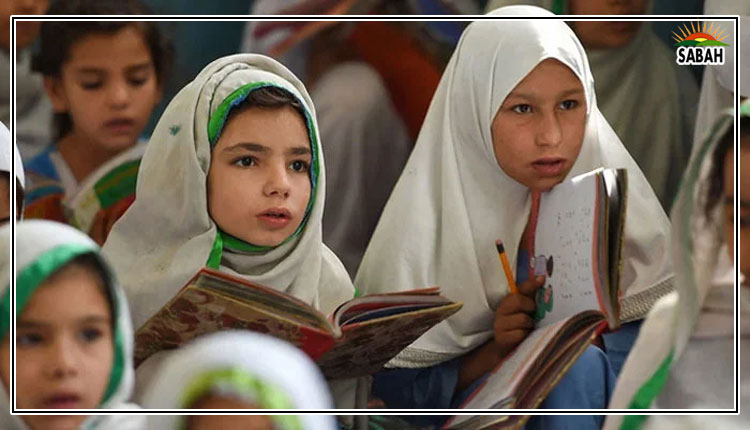Empowering girls…Laraib Kiani
In Pakistan, gender-based violence (GBV) is deeply rooted in traditional norms and cultural practices. While it affects women and girls from all backgrounds regardless of their social or economic status women and young girls from poor and marginalized households are most vulnerable to GBV.
GBV includes physical, psychological and sexual violence, trafficking, early or forced marriages, social and economic violence, and subjugation of womens agency.
Among these, one that stands out most and exacerbates womens vulnerability to other forms of GBV is the denial of girls right to education. Barriers in the fundamental right to education despite constitutional guarantees are a manifestation of misogynistic cultural norms and reinforce gender inequalities.
Girls experience higher school drop-out risk and fewer opportunities compared to boys in the face of similar challenges. It is also worth mentioning that educated and financially independent women also experience GBV albeit in other forms. Low womens representation in power corridors and senior management positions is somewhere connected with inequalities leading to gender-blind policies.
GBV thus becomes a self-perpetuating cycle, intensifying over time in the absence of concrete remedial measures. Depriving girls of education has prevailed due to various reasons such as cultural norms, poverty, political unrest, unsafe travel conditions and eve-teasing, population expansion and climate change. While this perception has changed in urban and peri-urban areas, girl education indicators from rural and less-developed areas remain worrisome.
According to the Pakistan Education Statistics (PES) 2021-22, nearly 39 per cent girls between ages 5-9 are out of primary school and 35 per cent girls between the ages of 10 and 12 and about 45 per cent girls between the ages of 13 and 16 are out of middle and high schools respectively.
Following the 18th Amendment, federal and provincial governments have attempted to address the over 26.2 million out-of-school children. However, inequitable education financing, policy inconsistencies and a lack of shared political vision have caused a downward trend in the number of schools. The lack of basic facilities like electricity and WASH in schools and the dearth of skilled teachers, especially in rural areas, have also exacerbated the problem.
Data reported in the PES 2021-22 suggests that for every 100 primary schools, there are about 29 middle and 21 secondary schools. These numbers further reduce for higher-secondary, universities and vocational training institutes. The report highlights that the progression rate from primary to middle school on average is 81 per cent and 90 per cent from middle to secondary. In this context, the downward trend in school numbers means an increased travel distance and pupil-teacher ratio and inevitably higher drop-out rates among girls.
Such education disparity not only exacerbates existing inequalities but also hinders womens socio-economic empowerment. Consequently, in Pakistan only 30 per cent of schoolgirls complete Grade 12 and enter the formal workforce, resulting in a dismal female labour force participation rate of 21 per cent with a majority of women engaged in informal sectors in low-paying jobs.
Girls education must be the vehicle to end GBV by adopting a holistic and all-inclusive approach. Gender sensitization is impossible without retaining girls in educational institutions. Increasing public investment in education and the provision of basic facilities such as boundary walls and WASH are crucial to reducing dropout rates. Conditional loans, financial assistance and safe transport for girls can increase enrolment and retention, especially in rural areas.
Where middle and secondary schools are far, adopting double shift models that cater to boys and girls in different shifts can reduce travel distance, which has a positive impact on girls enrolment and retention in schools. Inducting local graduates as teachers can increase the stake of local communities while also bridging the teacher shortage.
Comprehensive education policy reforms must include gender-sensitive curricula and teaching pedagogies that adopt inclusive language and foster critical thinking and open discussion so the young generation can challenge gender stereotypes.
Equipping students with knowledge about healthy relationships, consent, bystander intervention and communication skills can empower both genders to identify, prevent and respond to GBV. Imparting life skills among girls from an early age is paramount, as are income-generating skills especially ICT to enable financial empowerment.
Education institutions must establish robust counselling systems for students, parents and local communities, serving as vigilantes for prevention and reporting issues like sexual abuse and child marriages. Launching extensive advocacy campaigns to educate women about their rights; protection mechanisms against GBV; and complaint and redressal mechanisms along with strict law enforcement is imperative.
The prime ministers recent announcement of an education emergency is a timely step along with the governments various women-centric legislation. However, gaps in the implementation of gender-responsive budgeting especially in education, stall progress. The education emergency is a welcome gesture; but without grounding this vision in actionable and scalable policy interventions whose continuity is guaranteed through an all-party consensus, education equality will remain an uphill task.
For sustainable action against GBV through education, ensuring an inclusive and consistent education policy is a first step that can be achieved by adopting a nationally owned charter of education signed by all political parties to guarantee its uninterrupted implementation despite changes in political regimes.
Transforming education requires inclusive strategic planning with time-bound goals and robust monitoring and evaluation mechanisms while meaningfully engaging with academia, civil society organizations, youth and local communities. This also calls for more transparency and accountability by making credible financial and gender-disaggregated data, openly accessible to people.
The commitment to scale up public investment in education to a minimum of 4.0 per cent of the GDP to ensure free access of every child, especially girls, to the fundamental right to education needs to be fulfilled. It is also pivotal to prevent the commercialization of education and reduce existing inequalities.
The political leadership needs to unite on this agenda to show their commitment to bringing 26.2 million children back to school and ensuring the provision of quality education and life skills so children, especially girls, can become productive members of society.
Courtesy The News












